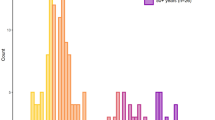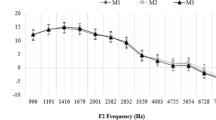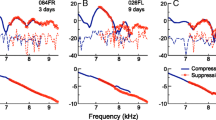Abstract
The amplitude of otoacoustic emissions (OAE) is known to decrease with increasing age, but it is still unclear whether this is due to aging alone or to age-related hearing loss. This study describes the exploration of a large database (5,142 patients from 0.4 to 89.8 years) collected in a routine clinical testing. Reliable pure tone audiograms, transitory evoked otoacoustic emissions (TEOAE) and distortion product otoacoustic emissions (DPOAE) recordings were available from 5,424 ears without conductive loss, acute sudden deafness or retrocochlear disorder. From this database, group 1 with behavioral thresholds of 10 dB HL or better at all frequencies from 1 to 4 kHz and group 2 with age-accordant thresholds after ISO 7029 were formed. In both groups, the OAE amplitude decreased with increasing age, but in group 1, the effect was significant only for DPOAE recorded at 3 and 4 kHz. In group 2, the loss of amplitude was steeper and highly significant for TEOAE as well as DPOAE at all frequencies, but most pronounced at high frequencies. These findings support the hypothesis that the reduction of OAE amplitude with increasing age is primarily caused by age-linked hearing loss and not by aging alone.








Similar content being viewed by others
References
Attias J, Furst M, Furman V, Reshef I, Horowitz G, Bresloff I (1995) Noise-induced otoacoustic emission loss with or without hearing loss. Ear Hear 16(6):612–618
Avan P, Bonfils P, Loth D, Elbez M, Erminy M (1995) Transient-evoked otoacoustic emissions and high-frequency acoustic trauma in the guinea pig. J Acoust Soc Am 97(5):3012–3020
Avan P, Elbez M, Bonfils P (1997) Click-evoked otoacoustic emissions and the influence of high-frequency hearing losses in humans. J Acoust Soc Am 101(5):2771–2777
Balatsouras DG, Tsimpiris N, Korres S, Karapantzos I, Papadimitrou N, Danielidis V (2005) The effect of impulse noise on distortion otoacoustic emissions. Int J Audiol 44:540–549
Bertoli S, Probst R (1997) The role of transient-evoked otoacoustic emissions testing in the evaluation of elderly persons. Ear Hear 18(4):286–293
Bonfils P, Bertrand Y, Uziel A (1988) Evoked otoacoustic emissions: normative data and presbycusis. Audiology 27:27–35
Castor X, Veuillet E, Morgon A, Collet L (1994) Influence of aging on active cochlear micromechanical properties and on the medial olivocochlear system in humans. Hear Res 77(1–2):1–8
Chan VSW, Wong ECM, McPherson B (2004) Occupational hearing loss: screening with distortion-product otoacoustic emissions. Int J Audiol 43:323–329
Collet L, Moulin A, Gartner M, Morgon A (1990) Age-related changes in evoked otoacoustic emissions. Ann Otol Rhinol Laryngol 99:993–997
Dhooge I, Dhooge C, Geukens S, De Clerk B, De Vel E, Vinck BM (2006) Distortion product otoacoustic emissions: an objective technique for the screening of hearing loss in children treated with platin derivates. Int J Audiol 45:337–343
Dorn PA, Piskorski P, Keefe DH, Neely ST, Gorga MP (1998) On the existence of an age/threshold/frequency interaction in distortion product otoacoustic emissions. J Acoust Soc Am 104(2):964–971
Gates GA, Mills D, Nam B, D’Agostino R, Rubel EW (2002) Effects of age on the distortion product otoacoustic emission growth functions. Hear Res 163:53–60
Hall AJ, Lutman ME (1999) Methods for early identification of noise-induced hearing losses. Audiology 38:277–280
He NJ, Schmiedt RA (1996) Effect of aging on the fine structure of the 2f1–f2 acoustic distortion product. J Acoust Soc Am 99(2):1002–1015
Hoth S (1996) Der Einfluß von Innenohrhörstörungen auf verzögerte otoakustische Emissionen (TEOAE) und Distorsionsprodukte (DPOAE) (The influence of inner ear hearing loss on transitory evoked and distortion product otoacoustic emissions). Laryngol Rhinol Otol 75:709–718
Hoth S, Polzer M, Neumann K, Plinkert P (2007) TEOAE amplitude growth, detectability, and response threshold in linear and nonlinear mode and in different time windows. Int J Audiol 46:407–418
ISO 7029 (2001) Acoustics: statistical distribution of hearing thresholds as a function of age. German version EN 7029:2000. Beuth, Berlin
Kimberley BP, Hernadi I, Lee AM, Brown DK (1994) Predicting pure tone thresholds in normal and hearing-impaired ears with distortion product emission and age. Ear Hear 15:199–209
Kon K, Inagaki M, Kaga M (2000) Developmental changes of distortion product and transient evoked emissions in different age groups. Brain Dev 22(1):41–46
Konopka W, Pawlaczyk-Lusczynska M, Sliwinska-Kowalska M, Grzanka A, Zalewski P (2005) Effects of impulse noise on transiently evoked otoacoustic emission in soldiers. Int J Audiol 44:3–7
Lapsley Miller JA, Marshall L, Heller LM (2004) A longitudinal study of changes in evoked otoacoustic emissions and pure-tone thresholds as measured in a hearing conservation program. Int J Audiol 43:307–322
Lapsley Miller JA, Marshall L, Heller LM, Hughes LM (2006) Low-level otoacoustic emissions may predict susceptibility to noise-induced hearing loss. J Acoust Soc Am 120(1):280–296
Lonsbury-Martin BL, Cutler WM, Martin GK (1991) Evidence for the influence of aging on distortion-product otoacoustic emissions in humans. J Acoust Soc Am 89(4):1749–1759
Lucertini M, Moleti A, Sisto R (2002) On the detection of early cochlear damage by otoacoustic emission analysis. J Acoust Soc Am 111(2):972–978
Morant-Ventura A, Marco Algarra J, Sequi Canet J, Caballero Mallea A, Mir Planas B (1999) Modifications of evoked otoacoustic emissions: study of age groups. Acta Otorrinolaringol Esp 50(5):355–358
Oeken J, Lenk A, Bootz F (2000) Influence of age and presbyacusis on DPOAE. Acta Otolaryngol 120:396–403
Plinkert PK, Hemmert W, Wagner W, Just K, Zenner HP (1999) Monitoring noise susceptibility: sensitivity of otoacoustic emissions and subjective audiometry. Br J Audiol 33:367–382
Plinkert PK, Hemmert W, Zenner HP (1995) Methodenvergleich zur Früherkennung einer Lärmvulnerabilität des Innenohres (A comparison of different audiometric methods for early detection of a vulnerable cochlea). HNO 43:89–97
Prieve BA, Falter SR (1995) COAEs and SSOAEs in adults with increased age. Ear Hear 16:521–528
Probst R, Harris FP (1997) Otoacoustic emissions. In: Alford BR, Jerger J, Jenkins HA (eds) Electrophysiologic evaluation in otolaryngology. Adv Otolaryngol 53. Karger, Basel, pp 182–204
Satoh Y, Kanzaki J, O-Uchi T, Yoshihara S (1998) Age-related changes in transiently evoked otoacoustic emissions and distortion product otoacoustic emissions in normal hearing ears. Auris Nasus Larynx 25(2):121–130
Schmuziger N, Patscheke J, Probst R (2007) An assessment of threshold shifts in nonprofessional pop/rock musicians using conventional and extended high-frequency audiometry. Ear Hear 28(5):643–648
Schmuziger N, Probst R, Smurzynski J (2005) Otoacoustic emissions and extended high-frequency hearing sensitivity in young adults. Int J Audiol 44:24–30
Stavroulaki P, Apostolopoulos N, Segas J, Tsakanikos M, Adamopoulos G (2001) Evoked otoacoustic emissions—an approach for monitoring cisplatin-induced ototoxicity in children. Int J Ped Otorhinolaryngol 59:47–57
Stenklev NC, Laukli E (2003) Transient evoked otoacoustic emissions in the elderly. Int J Audiol 42:132–139
Stover L, Norton SJ (1993) The effects of aging on otoacoustic emissions. J Acoust Soc Am 94(5):2670–2681
Acknowledgment
The authors gratefully acknowledge the valuable comments and recommendations of Prof. Dr. Rudolf Probst who left his initial role as an anonymous reviewer and contributed substantially to the final version of this paper.
Conflict of interest statement
The authors declare that they do not have any financial relationship to organizations that might have sponsored the research.
Author information
Authors and Affiliations
Corresponding author
Rights and permissions
About this article
Cite this article
Hoth, S., Gudmundsdottir, K. & Plinkert, P. Age dependence of otoacoustic emissions: the loss of amplitude is primarily caused by age-related hearing loss and not by aging alone. Eur Arch Otorhinolaryngol 267, 679–690 (2010). https://doi.org/10.1007/s00405-009-1106-5
Received:
Accepted:
Published:
Issue Date:
DOI: https://doi.org/10.1007/s00405-009-1106-5




